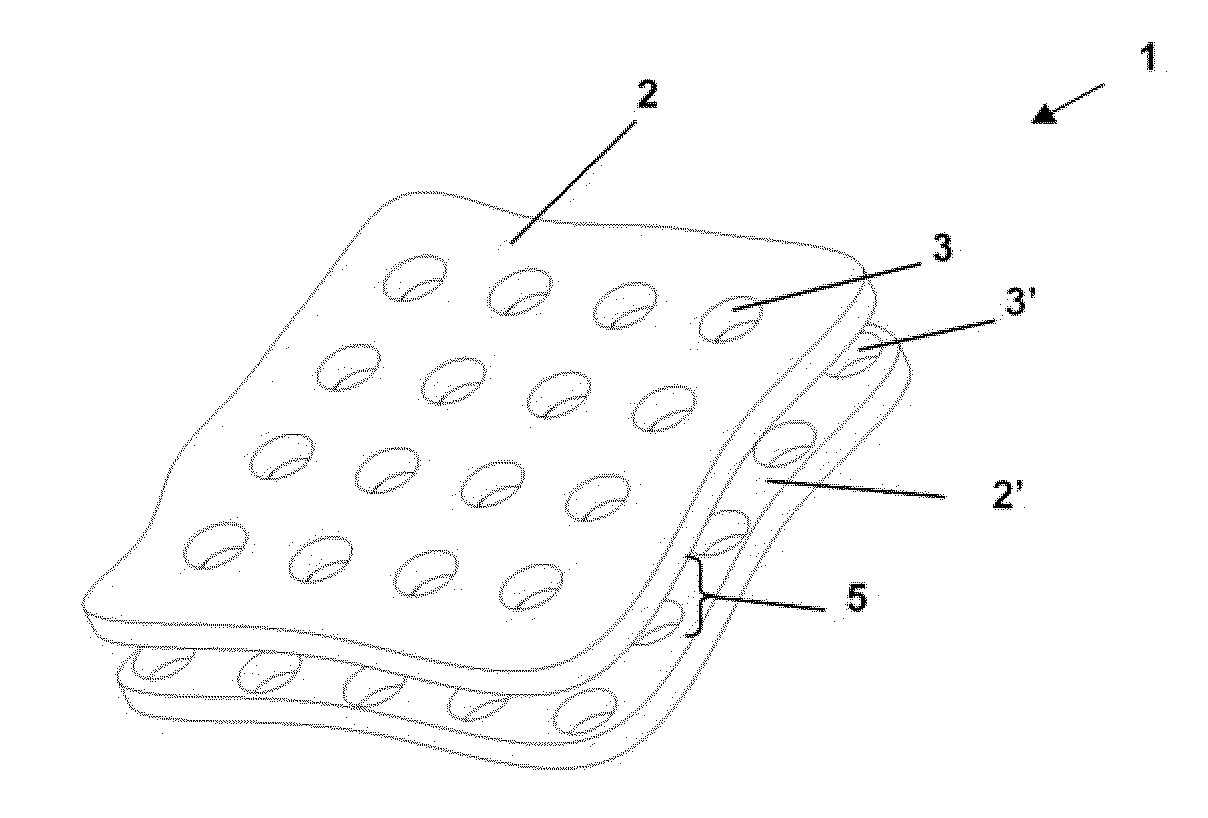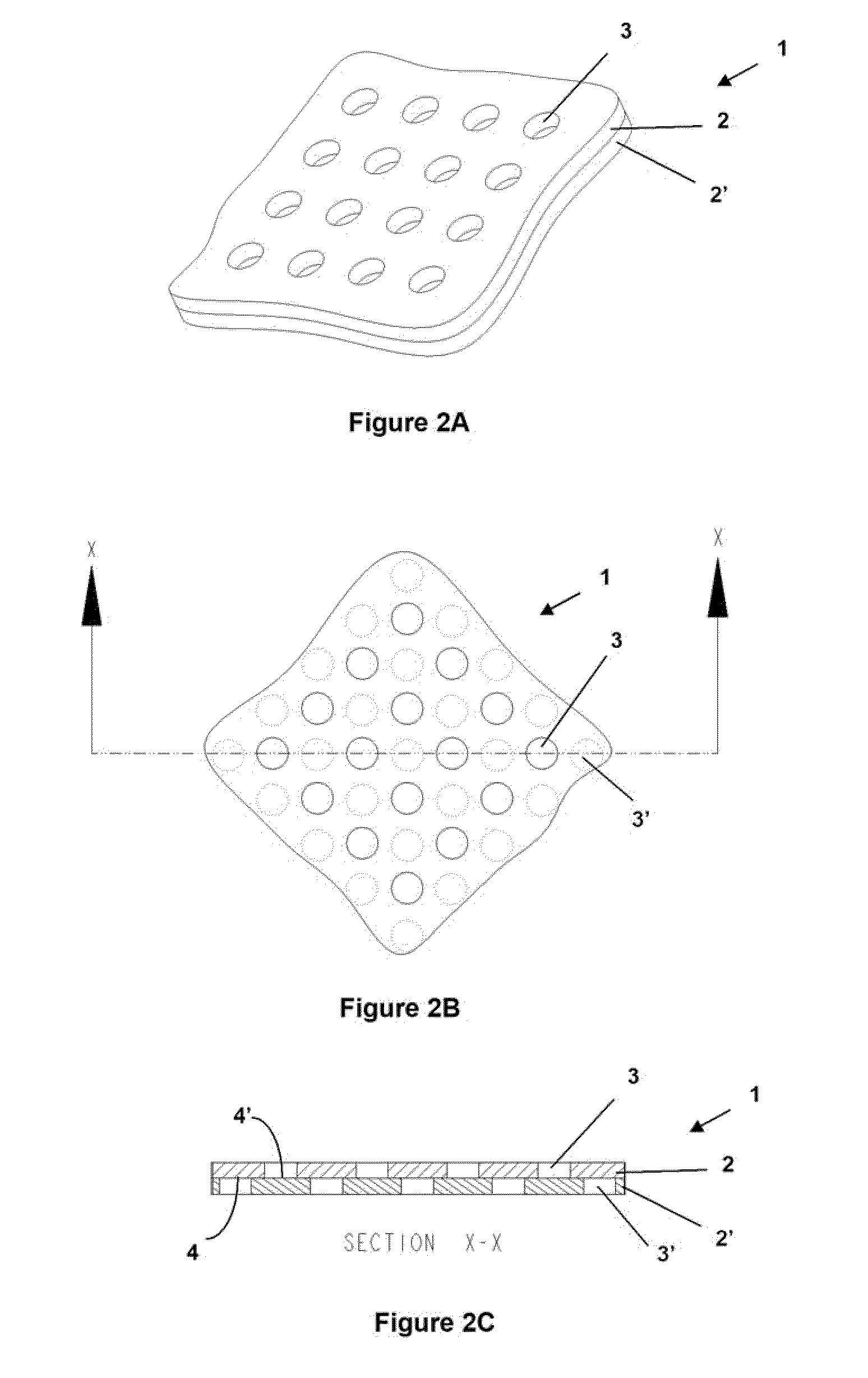Adaptive membrane structure
a membrane structure and adaptive technology, applied in the direction of humidity control, lift valve, feed/discharge of settling tanks, etc., can solve the problems of personal discomfort, difficult structure design, heavy and uncomfortable wear,
- Summary
- Abstract
- Description
- Claims
- Application Information
AI Technical Summary
Problems solved by technology
Method used
Image
Examples
example 1
[0116]Polyethylene terephthalate film, referred to herein as polyester film, sold under the trade name of Melinex® by DuPont Teijin Films, having a thickness of 196 gauge (0.00196″), was coated on one side with a thin layer of aluminum using a chemical vapor deposition process. The electrical resistance of a 2.5″ long by 2″ wide piece of aluminum-coated polyester film was measured using a two point probe apparatus. The resistance of the film was approximately 4 Ohms. The surface of the film that included the aluminum coating will be referred to as the conductive surface while the other surface that does not have the aluminum coating will be referred to as the non-conductive surface. Two circular (4″ in diameter) pieces of this polyester film were converted to a pair of membranes following the invention by punching holes through the polymer film and the conductive coating thereof. The diameter of the holes was 0.04″. Holes were punched using a VIPROS 345 turret punching machine manuf...
example 2
[0124]A pair of membranes was prepared from the same polyester film with conductive coating that was used for membranes in Example 1. The size of the holes, the hole pattern and the hole spacing in the membrane pair of this example were the same as those in the membrane pair of Example 1. The only difference between the membrane pairs of this example and the membrane pair of Example 1 was that the holes in the membrane pair of this example were created by laser drilling using a Lambda Physik (Gottingen, Germany) excimer laser Model LPX 220I operating at a wavelength of 193 nm.
[0125]An adaptive membrane structure was created by sandwiching one polyester spacer ring, 0.004″ in thickness as described in the previous example, between the two membranes. Note that the hole pattern in the two membranes was offset from each other, and when the membranes are assembled, the holes in one membrane were thus out of registration with the holes of the other membrane. Also, when the membranes were ...
example 3
[0126]Two rectangular pieces (6″×5″) of the same polyester film with conductive coating used in Example 1 were washed for one hour in a 5 wt % aqueous solution of DuPont Oxone® monopersulfate compound, obtained from Aldrich Chemical Company, Inc. (Milwaukee, Wis.). This washing process completely removes the conductive coating from the surface of the films. The excimer laser apparatus, described in Example 2, was then used to drill holes into the uncoated polyester films. The diameter of the holes, the pattern of holes and the spacing between the holes was the same as created in the membrane pairs of Example 1 and Example 2.
[0127]The membrane pair with conductive coatings from Example 3, the uncoated membrane pair from this example and three polyester spacer rings (one between each adjacent membrane) were combined to form a membrane assembly comprising the four membranes. FIG. 17 shows the make up of the membrane assembly. When the assembly was created, care was taken to ensure that...
PUM
| Property | Measurement | Unit |
|---|---|---|
| area | aaaaa | aaaaa |
| porosity | aaaaa | aaaaa |
| diameter | aaaaa | aaaaa |
Abstract
Description
Claims
Application Information
 Login to View More
Login to View More - R&D
- Intellectual Property
- Life Sciences
- Materials
- Tech Scout
- Unparalleled Data Quality
- Higher Quality Content
- 60% Fewer Hallucinations
Browse by: Latest US Patents, China's latest patents, Technical Efficacy Thesaurus, Application Domain, Technology Topic, Popular Technical Reports.
© 2025 PatSnap. All rights reserved.Legal|Privacy policy|Modern Slavery Act Transparency Statement|Sitemap|About US| Contact US: help@patsnap.com



